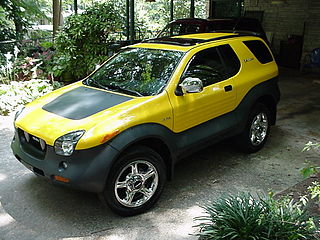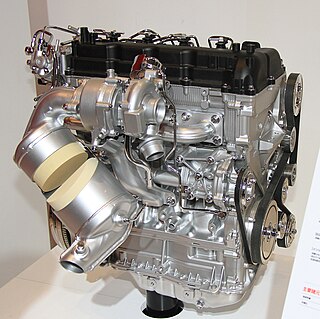
Peugeot is a French automotive manufacturer, part of Groupe PSA.

The Mitsubishi Lancer Evolution, also known as 'Evo', is a sports sedan based on the Lancer that was manufactured by Japanese manufacturer Mitsubishi Motors from 1992 until 2016. There have been ten official versions to date, and the designation of each model is most commonly a Roman numeral. All use two litre turbocharged inline four-cylinder engines and all-wheel drive systems.

Mitsubishi Colt is a nameplate from Mitsubishi that has been applied to a number of automobiles since 1962. It was first introduced with a series of kei and subcompact cars in the 1960s, and then for the export version of the subcompact Mitsubishi Mirage between 1978 and 2002. Chrysler, Mitsubishi's longtime partner, also used the name when applying its long-running practice of rebadging Mitsubishi vehicles as the Dodge and Plymouth Colt captive imports for the North American market between 1970 and 1994.

The Isuzu VehiCROSS is a compact SUV from Isuzu. Produced from 1997 through 2001, it shares many of its components with the Trooper, including both its 3.2 L and 3.5 L V6 engine that produces 215 bhp at 5400 rpm and 230 lb⋅ft (312 N⋅m) at 3000 rpm of torque. The vehicle also features the Torque on Demand (TOD) 4-wheel-drive system produced by BorgWarner. It is a small, sporty 2-door crossover vehicle with aggressive external styling, including short overhangs, an aggressive forward stance, titanium "teeth" in the grille, a black hood-insert, and black plastic cladding over the entire lower half of the vehicle. The US VehiCROSS came equipped with 16" polished wheels in 1999 and 18" chrome wheels during the remainder of production. The Japanese version came equipped with 16" alloys with chrome center caps.
Olivier Boulay is an automobile designer. Starting from 2009, he is the Vice President of Daimler's Advanced Design Centre in Beijing, China.

Mitsubishi Motors Australia Limited (MMAL) is a fully owned subsidiary of parent company Mitsubishi Motors Corporation of Japan. The company was established in 1980 and began vehicle manufacturing in that year, having taken over the facilities of Chrysler Australia. Australian production ceased in 2008 and since that time the company has been exclusively a vehicle importer. MMAL spare parts facilities are located in Adelaide and Sydney.
Ralliart is the high-performance and motorsports division of Mitsubishi Motors. It was responsible for development and preparation of the company's rally racing and off-road racing vehicles, as well as the development of high-performance models and parts available to the public. Ralliart scaled down its business activities in April 2010, though the brand will continue to be used by Mitsubishi.
South East (Fujian) Motor Co., Ltd., trading as Soueast, is a Chinese automobile manufacturer based in Fuzhou, Fujian, and a joint venture between China Motor Corporation (25%), Fujian Motor Industry Group (50%) and Mitsubishi Motors (25%). Its principal activity is the design, development, production and sale of passenger cars and minibuses sold under the Soueast marque. It also manufactures Mitsubishi brand passenger cars for sale in mainland China.

The Mitsubishi Galant VR-4 was the range-topping version of Mitsubishi Motors' Galant model, available in the sixth (1988–92), seventh (1992–96) and eighth (1996–2002) generations of the vehicle. Originally introduced to comply with the new Group A regulations of the World Rally Championship, it was soon superseded as Mitsubishi's competition vehicle by the Lancer Evolution, and subsequently developed into a high-performance showcase of the company's technology.
The Mitsubishi 8A8 engine is a range of V8 powerplants produced by Mitsubishi Motors since 1999. The only variant to date is the 8A80, a 4.5 L (4,498 cc) with double overhead camshafts and gasoline direct injection (GDI) technology. Financial pressures forced the company to discontinue sales of the Proudia and Dignity, the only vehicles in its range to which it was fitted, after only fifteen months.

The Mitsubishi RVR is a range of cars produced by Japanese manufacturer Mitsubishi from 1991 to 2002 and then from 2010 until present. The first two generations were classified as compact multi-purpose vehicles (MPV), whereas the model introduced in 2010 is a subcompact crossover SUV.
MIEV or MiEV is the name given by Japanese automaker Mitsubishi Motors (MMC) to its alternative propulsion technologies. From late 2006, “MiEV” encompasses all of Mitsubishi Motors’s electric drive systems work, including lithium-ion batteries, in-wheel motors and other technologies related to electric vehicle(EV), hybrid-electric vehicle and fuel-cell vehicles.

The Mitsubishi Nessie is a concept automobile co-developed by Italdesign Giugiaro, The Linde Group and Mitsubishi Motors, and exhibited at the 2005 Geneva Auto Show. It is the latest in a line of SUVs, space-wagons and alternative architectures designed by Giugiaro dating back to 1978 and the Lancia Megagamma, with more recent examples including the Giugiaro Touareg (2002), Maserati Kubang (2003) and Volkswagen Tarek (2003).

The Toyota Camry TS-01 is a concept car based on the Toyota MCV30 Camry. It was designed and built mainly using resources of Toyota Australia, and was unveiled at the 2005 Melbourne International Motor Show in Australia.

The Mitsubishi Colt 800 is the first of a series of passenger cars with a fastback/hatchback design produced by Mitsubishi Motors from November 1965. It was introduced as a two-door fastback sedan, the first such design in the Japanese market. The series was discontinued in 1971, after the introduction of the company's Galant sedan but without a real replacement.
The MR name is short for Mitsubishi Racing, and has nothing to do with mid engines {Infobox automobile platform | name = Mitsubishi MR platform | image = Mitsubishi i 2.jpg | caption = The rear suspension of the Mitsubishi i as seen in cutaway, showing the engine behind the rear seats and under the floor of the rear hatch storage area, just ahead of the rear axle. | aka = | manufacturer = Mitsubishi Motors | predecessor = | successor = | production = January 2006–present | class = Kei car | engine = | transmission = | front_suspension = MacPherson struts | rear_suspension = De Dion tube/Watt's linkage | wheelbase = 2,550–2,600 mm (100.4–102.4 in) | related = | vehicles = Mitsubishi i }}
Mitsubishi Motors concepts are those prototype and concept cars exhibited around the world by Mitsubishi Motors. In common with other automakers, Mitsubishi has used concept cars as both show cars—stylistically adventurous motor show exhibits with no production intentions behind them—or as precursors of future models destined for mass production.

The Mitsubishi 4N1 engine is a family of all-alloy four-cylinder diesel engines developed by Mitsubishi Motors, produced at the company's powertrain facility in Kyoto, Japan for use in Mitsubishi's small to mid-sized global passenger cars.

The Mitsubishi MiEV Evolution is an electric motor racing car project, managed by Mitsubishi Motors. The project originated prior to 2012, producing a vehicle that entered in the 2012 Pikes Peak International Hill Climb (PPIHC) event, and has undergone evolution and technical improvements in subsequent years. The 2014 version achieved 2nd and 3rd position overall in the 2014 PPIHC event, with run times within 3 seconds and 7 seconds (respectively) of the overall fastest vehicle, a gasoline-powered Norma race car.















